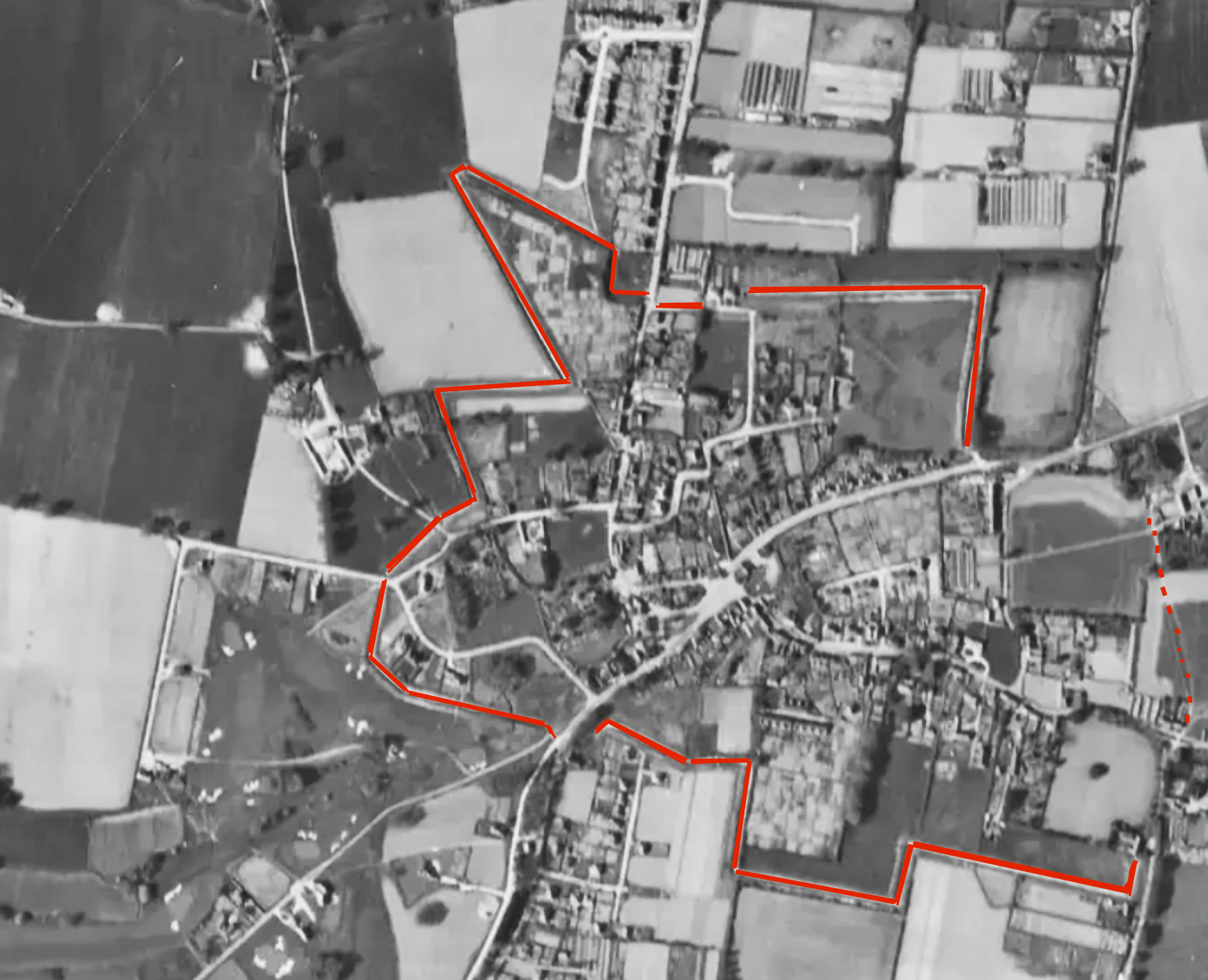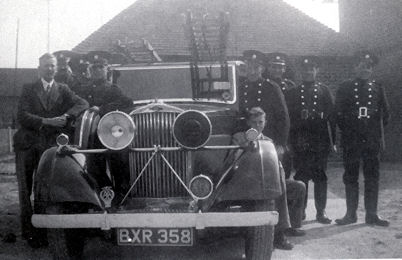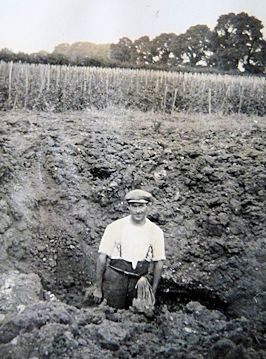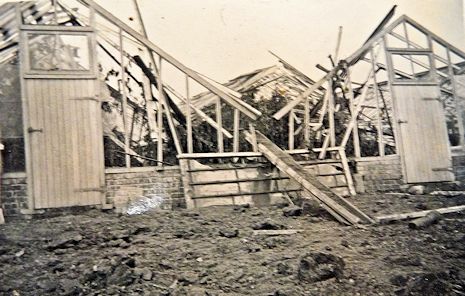
While across Britain much has been written about WW2 life, comparatively little was recorded about life in towns and villages in the earlier conflict. In Angmering, we are fortunate enough to have the jottings of William Hollis between 1916 and 1918 in his news sheet “Scribble”. But that tells us more of the soldiers’ whereabouts and fate and of peace celebrations in the community, rather than the experiences of the village population and the impact of WW1.
We fare much better with WW2 records, and this article is therefore devoted to bringing together memories of that period and other information that is in the public domain.
But here again we face a slight problem. It was only in the last 30/40 years that people really became interested in recording personal history. By that time, a considerable part of the adult population who had lived through WW2 had either passed away or who had come from a generation who saw little value in sharing their memories with others. This therefore leaves us largely with memories seen through the eyes of the children of the period who may have been shielded from some of the horrors of war and the privations experienced by their parents.
This article is an initial attempt to document wartime Angmering but it is expected to expand or be modified when further information comes to hand.
At an early stage it was recognised that the South Coast of England was vulnerable to invasion by enemy forces. The local primary defences were at Angmering-on-Sea, but the government wished to protect towns and villages from enemy surges through populated areas should an invasion occur,and particularly those in strategic positions.
Anti-tank areas were therefore established which later became known as Nodal Points and Angmering was selected as one of these. The main reasons for selection were probably its near coast location, and its proximity to the radar station at Poling. Nodal Points were governed by a triumvirate consisting of the local military commander, the chairman of the parish council, and the senior police officer.
Local resident Cyril Bagg has previously stated that a "v-shaped" anti-tank ditch ran from just south of the cottages in Roundstone Lane across to Station Road.
Through the Duke of Norfolk’s archives, we knew more or less what was put in place on the west side as this impacted on his land. A ring of 15ft deep "v-shaped" anti-tank ditches were put in place in the fields west of the Rectory which then ran north between Church Farm House and Old Place Farm. The ditches then turned east and met up with Arundel Road. The road itself was protected by small blocks which could be raised from under the road. The defences then proceeded east along the north side of Lansdowne Way where standard 5ft x 5ft concrete anti-tank blocks were positioned. From there, the defensive position ran in more or less a straight line down to Water Lane to the entrance of the short footpath to where Greenacres Ring is today.
On the south-east side of the village, local resident Cyril Bagg has previously stated that a "v-shaped" anti-tank ditch ran from just south of the Dane Villas cottages in Roundstone Lane across to Station Road but the exaxt positions were unknown. However, in 2024, Historic England published aerial photos of the area taken by the USAAF in 1944. This has allowed the author of this article to plot most of the Angmering tank traps, although they are difficult to accurately identify on the eastern side of the village, particularly between The Spotted Cow and Avenals Farm. (see photo below) The defences were mainly 15ft deep "V"-shaped ditches, plus some 5ft concrete cubes and some 3ft pyramids/dragons teeth.

To the east of that footpath along the bank running east to a point 30 yards west of Dappers Lane, a small minefield (serial no. 30B) was laid consisting of a magnetic resonance mine at each end - mine serial no. M.R. 50652389 on the west end and mine serial no. M.R. 50712392 on the east end. (NB. These mines were certified on 22 September 1944 as having been removed and the area considered safe). More concrete blocks were established in this area protecting the areas to the sides of the roads.
Alongside many of the roads, camouflaged Fougasse land mines were placed. These consisted of buried 40 gallon oil drums filled with highly inflammable liquid and shrapnel. Early in the war, these were to be ignited - somewhat dangerously - by dropping a grenade down a funnel, but later they were to be ignited by remote controlled detonators.
Additionally, to protect the coastline in the event of an attempted invasion, numerous gun batteries were set up 3-4 miles inland. In the early years of the war, one of these, consisting of four 75mm guns, was located in Angmering on Ecclesden Common (near Patching). It was manned by Territorial Army gunners of the 114th (Sussex) Field Regiment of the Royal Artillery. These guns had a sweep of fire from Ferring to Rustington.
Every house in the village was provided with a Morrison shelter, which was supposed to be erected inside the house. However, some houses were too small to accommodate these and they were erected in the garden in some way or, in the case of some Water Lane houses, in the bank behind the houses.
Following the experiences of WW1, everybody was required to carry gas masks, especially in the early stages of WW2, and this of course included children. Air raid drill was also regularly carried out at the schools where, on a signal, children had to get underneath their desks which provided a modicum of protection.
 William Older's Charity School protected
its windows from shattering by covering them in resin with cross bands of paper
over each pane.
William Older's Charity School protected
its windows from shattering by covering them in resin with cross bands of paper
over each pane.
An air-raid shelter was provided in the village in the bank opposite the village hall. There is no evidence that it was greatly used during the war and it was sealed up in the 1960s as it was being used by the youth of the village for “doubtful” purposes! It still lies beneath the grass bank and a bungalow has been built above it. There is a man-hole in the path above the bank which some villagers claim to cover the shelter's escape hatch but this was later subsequently disproved and I beleive the escape hatch is under the bungalow above which was built later.
An anti-aircraft “ack-ack” gun was later positioned in a pit in Fletcher’s Field at the corner of Arundel Road and Rectory Lane. This was manned by soldiers who were stationed in the village.
In 1940, a fire engine and equipment (then worth £1000) (see photo right) was given to the village by a resident of The Thatchway. To complement this, a brick water tank was built in the church car park which was intended to act as a reservoir for fire fighting in the village centre should it be needed. Children used this as a skating rink when it froze over. The fire station was located in a small bungalow in Palmer Road which can be seen behind the fire engine in the photo..
At stages during the war, armies from various countries were stationed and trained in and around Angmering. These included Canadians, Australians, the Welch Fusiliers and Americans. The Australians appear to have been mostly employed in sawmills at Swillage. Angmering Woods and the Downs beyond provided excellent areas for the training of troops.
After the disastrous British Expeditionary Force campaign, troops were hurriedly evacuated from Dunkirk to reception camps all over England. Subsequently, the 1st Battalion of the Grenadier Guards moved to Littlehampton on 19 June 1940 and then set up their HQ at the Norfolk Hotel in Arundel on 23 June. No 2 and No. 4 Coys then moved to Angmering Park Farm on 23 and 24 June respectively where they re-grouped and were called the Left Half Battalion. Other Companies stationed in Arundel Park were termed the Right Half Battalion. During their short time in Angmering, No. 4 Coy trained with the Royal Navy at Whale Island, Portsmouth, and helped clear the beach fronts of civilians. However, on 12 July 1940, the whole battalion moved by road and rail to the Cotswolds.
Other army units stayed longer. The Village Hall was commandeered for the army, and activities of the civilian population had to be held elsewhere. However, the army did put on film shows which were also enjoyed by villagers although children were sometimes prevented from seeing films considered more suitable for adults. That, however, did not stop them sneaking in through a toilet window!
Empty houses, or “second properties” were used to billet soldiers. Sadlers and Russets in the High Street were used for such purposes as were the eastern pair of semi-detached houses opposite (now Penview & The Warren). The officers, of course, had the best accommodation, many being stationed in the large unsold or commandeered houses in The Thatchway!
For a time Anchor Cottages in the un-named lane off the High Street (by Chants) were used as a jailhouse, and the Canadians used a building by The Lamb Inn as a NAAFI canteen.
An army assault course was established at the bottom of The Thatchway (where Field House is now) which abutted Black Ditch. The village children enjoyed playing on this and only a few minor injuries were sustained. They also enjoyed jumping from one anti-tank block to another in various locations in the village.
Our own Home Guard had its Platoon HQ at Eachways in The Square while the ARP’s HQ was located in a small building at the far south end of Elmgrove (just north of the village air-raid shelter). The Angmering Home Guard was 8 Platoon of “C” Company within the 6th (Arundel) Battalion Sussex Home Guard.
Armed conflict, such as friendly fire, can result in unexpected tragedies. In Angmering, this took the form of the death of Platoon-Sergeant John Grenville Anderson in 1941, who was teaching a 14-year old messenger boy with the Home Guard - Peter Balham - to aim a rifle at the former's home in Station Road. Unfortunately, a live round - previously thought to be a dud - was somehow mixed with dummy cartridges in the magazine of the rifle which the boy was aiming at a target held by his instructor. When the trigger was pulled, the instructor was fatally shot in the head. The subsequent inquest recorded a verdict of accidental death.
Early on, the War Office demanded allotments land for military purposes, and 15 plots were so allocated to them by the Parish Council. By 1942, the War Office was demanding that much of the South Downs was cleared for military use and particularly the high farms on the Downs. One of these that had to be evacuated was Lee Farm, in the far north of Angmering, which was also used for target practice. But that was not the only thing to be shot at. When the old weather vane on St Margaret's Church was taken down some years ago, a bullet hole was found on it!
Operation Pied Piper, which began on 1 September 1939, officially relocated 1.5 million people in the UK. In the first three days of official evacuation, of the 1.5 million people who were moved, 827,000 were children of school age. These mainly came from the big cities which were vulnerable to enemy attack. Here in the South, large contingents came from the London area. It was thought that the South Coast would be safer although later, after the fall of France, the number of children evacuated to the South Coast fell considerably and some here were probably re-evacuated.
Initially, 223 unaccompanied children were scheduled for evacuation to Angmering, 198 to East Preston, and 566 to Rustington, although the actual number may not have reached anywhere near the schedules. Some teachers and helpers also arrived with the children. All of these arrived at Worthing Station - no doubt over a period of days - which appears to have been the railhead for this area. From Worthing Station, the Angmering-based children were bussed to Angmering Village Hall where they were passed over to their host families. Interestingly, the headmaster of Angmering's Olders School, Mr A.G.E. Russell, was appointed as the Liaison Officer for the Worthing area which stretched from Sompting to Rustington.
Apart from the difficulties that many evacuated children had with the families with whom they had been billeted, there were also difficulties absorbing them into the schools in the area where the number of evacuees allotted was greatly in excess of school accommodation.
There’s nothing to suggest that the relationship between villagers and the troops was anything but cordial. The troops were grateful for the small kindnesses that villagers were able to offer and returned favours whenever they could – especially towards the children. The children delivered bread to the troops from the Canadians’ bakery and in return received scraps to feed their pets.
At a party for children in the Village Hall, the Canadians provided bananas – such a rare commodity – the first time many of them had encountered the fruit. Later, the Americans were stationed in the village and generously gave the children large chocolate bars and sometimes their one-day “K” ration packs.
The radar station men from Poling had few facilities there and villagers would help out by providing bathing facilities. In return, they provided more coal for heating water.
On Sundays, French-Canadian troops paraded in Lansdowne Way and would march down to St Wilfrid’s RC Church for services.
At William Older’s School, the older girls played their part by knitting socks for the various forces.
As everywhere else, food was in short supply. Gardens and allotments were used for growing vegetables and the boys at William Older’s School grew more in the school garden (now St Nicholas Garden). Fathers working on the farms were often fortunate to be able to bring home some poultry at Christmas or the occasional rabbit.
Sweets were on ration and in exceptionally short supply, and an alternative was to buy tasty OXO cubes from Cheesman’s Stores in The Square at two for 1d.
Clothes were also on ration and there was much “make do and mend” or adaptation. Many girls knitted their own cardigans in addition to the socks they knitted at school for the armed services.
Scarcity of paper and ink had an impact on school work but the children at Older’s School still managed to produce a booklet in 1944 entitled “Our Village” which was sold for 6d each. Scrap paper was collected and put into a tin shed on The Green for re-cycling.
Children had to earn their pocket money which they did by fair means or foul. One popular way was taking empty beer bottles left for collection outside The Lamb and ”re-returning” them to the landlord who would give 2d for them! Money earned would often be spent on a portion of chips from Norris’s fish and chip shop.
Irrespective of the shortages, villages did their best to help the war effort. Roy Green recalls that, in the early 1940s, Angmering ran a fund to purchase a Spitfire. It ran over several years with various jumble sales, dances etc contributing to the fund, and there was a Spitfire day each year with a door to door collection. For a donation you would be given a celluloid cut-out of a Spitfire with a pin. These were in various colours - red, white, blue and green - and were prized collections for the local children at school. Eventually the grand sum of £3,000 was raised which was the cost of producing a Spitfire. This was presented to an R.A.F officer and Roy seems to remember that the children were told that the Spitfire purchased would bear the name ANGMERING. £3,000 was a considerable sum of money in those days and the village was very much smaller although the population was boosted by all the service personnel.
Being close to the Chain Home early warning Radar Station adjacent to Peckhams Farm, Poling, exposed Angmering to unwanted attention from the enemy, although nearby bombing was probably not intended for the village itself.
A sustained attack on the Radar Station at lunch-time on Sunday 18 August 1940 had everyone running for shelter. Some 70 Junkers Ju87 and 24 Ju88 bombers escorted by Messerschmitt Me109 fighters dropped 44 high explosive bombs that brought down two of the 100m high radar latice towers which immobilised operations at the station. Replacement masts were later erected in Angmering woods where there was less chance of them being spotted.
During that raid, a Junkers Ju 87B Stuka, from the Luftwaffe Unit: II Gruppe - Stukageschwader 77 - 5 Staffel crashed landed on Ham Manor Golf Course (see photo below). The Pilot was taken prisoner, but the Wireless Operator died of his wounds which were said to have been the result of being shot by the Home Guard when he started to fire his pistol at them. However, this is disputed and other souces claimed he had been shot during an air battle. He was originally buried at Littlehampton Cemetery but moved c1965 to the Deutscher Soldatenfriedhof, the German Military Cemetery at Broadhurst Green on Cannock Chase, Staffordshire.

An air fight took place over Angmering during the Battle of Britain which, rather unwisely, all the villagers came out to watch.
An unpredictable V1 (doodlebug) rocket fell one night on the sawmills at Swillage but there were no casualties. Later, also at night, an enemy aircraft, supposedly returning from an unsuccessful mission to London, jettisoned its load over Angmering which fell into fields adjoining Dappers Lane. Again, fortunately, no one was hurt but villagers were clearly shaken by this incident which shattered many windows in Angmering.
The biggest terror for a number of children in the village occurred when they were helping bag potatoes in a field near Dappers Lane. A German fighter appeared and strafed the field with machine-gun fire. The farmer wisely had taken some precautions by building a shelter out of straw bales and managed to get the children into the shelter but, in the process, was himself wounded in the leg.
Police files record many incidents of bombing raids on Angmering although not every one may have been reported. Angmering was comparatively lucky compared with East Preston where several civilians were killed or injured during the war, and damage to property was far more extensive. Recorded raids on Angmering were as follows:
|
Date |
Time |
HE Bombs Dropped |
|
| 15 July 1940 |
1500 |
5 |
|
| 13 August 1940 |
0840 |
- |
|
| 31 October 1940 |
1245 |
2 |
|
| 2 December 1940 |
1848 |
2 |
|
| 12 January 1941 |
2042 |
- |
|
| 8 March 1941 |
2230 |
1 |
|
| 8 March 1944 |
2125 |
1 |
|
| 14 April 1944 |
0125 |
2 |
|
| 28 May 1944 |
2340 |
1 |

Bomb crater

Damage to property was mostly caused to greenhouses (see photo right). However, individuals' properties were damaged during some of these raids. There is a record of the raid on 15 July 1940 which caused £916 of damage in Angmering and East Preston, which included £333 of damage to these Angmering Nurseries/Properties:
| Property | Damage | |
| Sirseah Nursery, Station Road | £198 | |
| Gable Nursery | £6 18s | |
| Dell Nursery, Station Road | £6 | |
| Roundstone Nursery | £4 11s | |
| Percivals Nursery, Station Road | £1 | |
| Orchard House, Roundstone Lane | £75 | |
| Damage to crops (all nurseries) | £42 |
Towards the end of the war, German and Italian prisoners appeared. They were put to work on the farms and in Angmering Woods. Bright orange patches were sewn on their clothing for identification purposes.
On occasions, prisoners who could speak English, went into the village schools and gave talks to the children.
Unlike the end of WW1, there does not appear to have been a massive single village celebration on the cessation of hostilities. Instead smaller celebrations such as street parties seem to have taken place, probably the largest being held in Lloyd-Goring Close, chosen because the road was more or less uninhabited at that time – the war interrupting new building construction.
Maybe the reason for the smaller scale celebrations was that the size of the village had nearly doubled between 1918 and 1945. Notwithstanding that, a Thanksgiving Service was organised by Angmering Parish Council for all villagers.
The Council also had other things to consider, one of which was the removal of the anti-tank blocks and the release of ground from the War Agricultural Committee in order that land could return to its original use.
Some soldiers came back to the village after the war. Two from the Royal Welch Fusiliers returned and married Angmering girls and settled in the village.
Sadly, about a dozen villagers paid the ultimate sacrifice during the conflict and never returned. Details of these can be found on the War Memorial page.
(Author's Note: I would like to thank contributors to “Angmering – Reminiscences of bygone days” and especially Roy Green from whom I have drawn heavily from his childhood memories and who has also provided me with additional information. Also I wish to thank John Wells of Selsey who has provided much of the information relating to wartime defences, and Richard Standing for details of bombings and damage. Additional information received from Robert Hammond and Cyril Bagg. I would also welcome any further information that readers are able to contribute.)